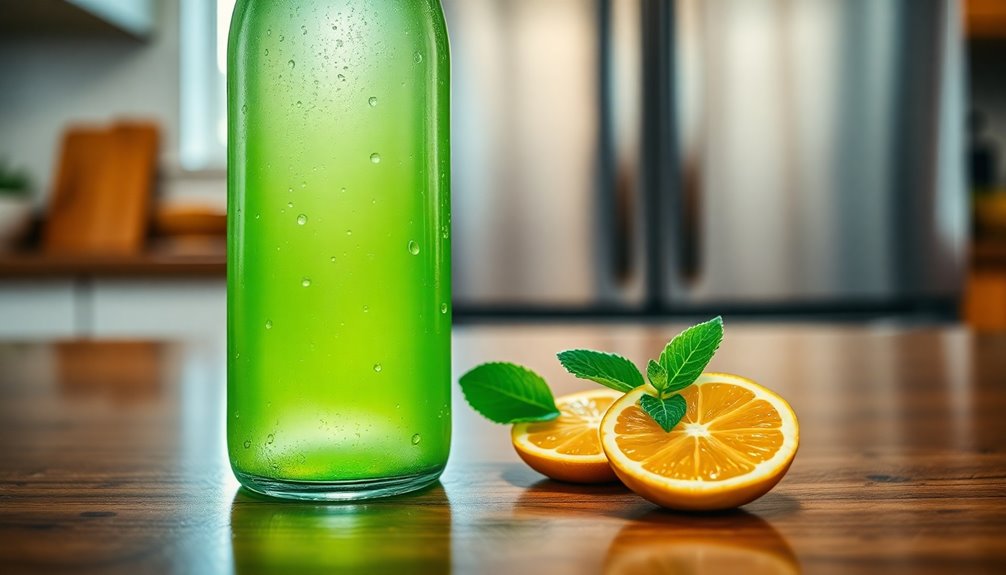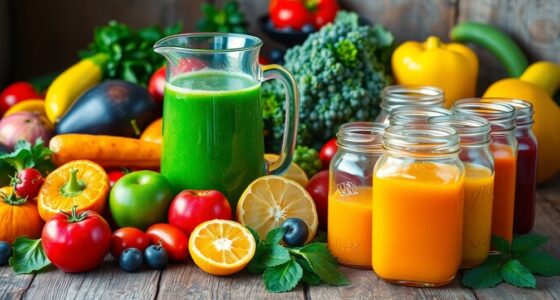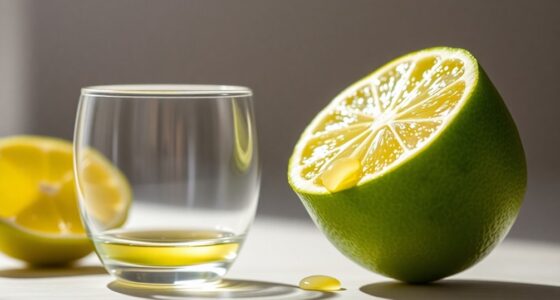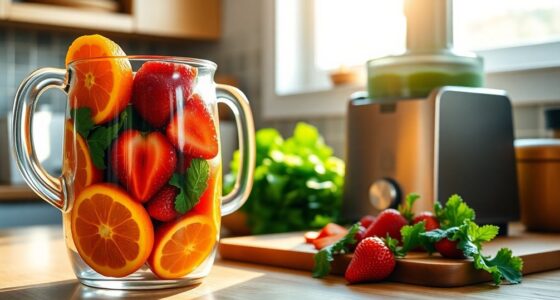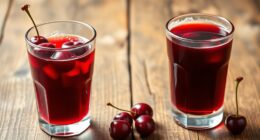Bottled lime juice lasts between 12 to 18 months in the fridge when unopened. Once you open it, try to use it within 1 to 2 weeks for the best taste. Always check the expiration date to ensure quality. Even past this date, it might still be safe to drink, but the flavor could fade. If you're curious about proper storage tips and signs of spoilage, there's more valuable information to discover.
Key Takeaways
- Unopened bottled lime juice lasts 12 to 18 months in the refrigerator, depending on storage conditions.
- Always check the expiration date for best quality, but it can be used beyond that date.
- Opened bottled lime juice is best consumed within 1 to 2 weeks for optimal flavor.
- Store opened lime juice in an airtight container and refrigerate immediately to maintain freshness.
- Signs of spoilage include off odors, unpleasant flavors, and visual changes like mold; discard if any are present.
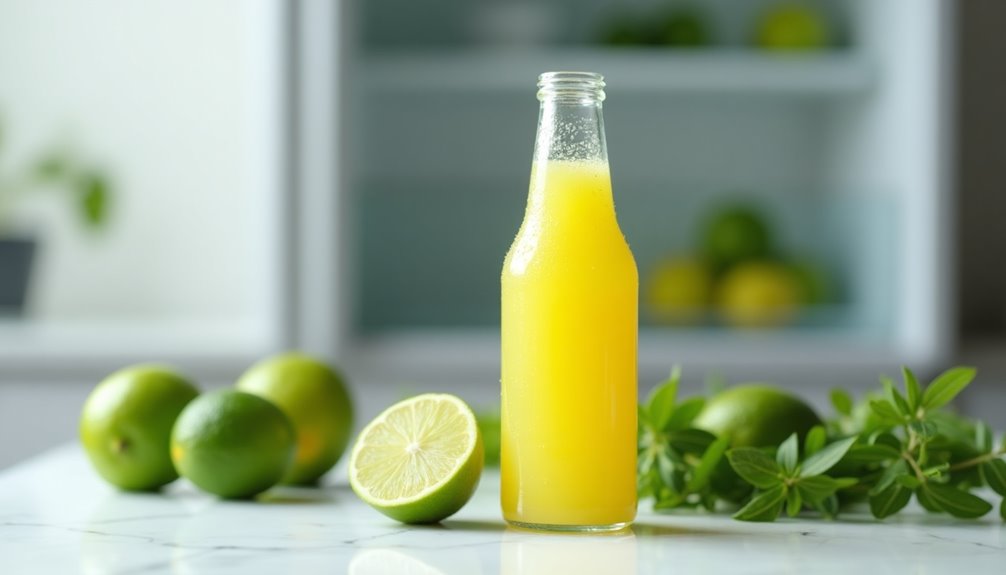
When you reach for that bottle of lime juice, you might wonder how long it'll stay fresh. Knowing the shelf life of lime juice can help you keep your drinks and recipes tasting their best. You'll find that the longevity of bottled lime juice varies depending on whether it's opened or unopened.
Unopened bottled lime juice can last an impressive 12 to 18 months when kept in the refrigerator. However, it's crucial to always check the expiration date on the packaging. This date indicates the best quality, not necessarily safety, so you may still find it usable beyond that point, albeit with some potential quality decline.
Once you pop the cap on that bottle, the rules change. Opened bottled lime juice is best consumed within 1 to 2 weeks for optimal freshness. After this period, the quality can start to deteriorate, so it's wise to keep an eye on how long it's been since you first opened it.
Proper storage is essential in this case. Always remember to refrigerate opened bottled lime juice and keep it in an airtight container. This small step can significantly prolong its freshness and flavor.
As you use your store-bought juice, be alert for signs of spoilage. If you notice off odors or unpleasant flavors, it's a clear indication that the juice has gone bad. Visual changes like mold are another sign you shouldn't ignore. If you see any of these signs, it's best to discard the juice to avoid any unpleasant surprises in your dishes or drinks.
For unopened lime juice, storing it in a cool, dark place is key. Even though it's safe to use past the expiration date, you might notice that the taste isn't as vibrant as when it was fresh. This is a common occurrence with any bottled juice, as flavors can fade over time.
Proper storage ensures you keep that crisp taste for as long as possible, enhancing your culinary creations. If you're ever in doubt about the quality of your lime juice, don't hesitate to taste a small amount before using it in your recipes.
It's a straightforward way to ensure you're working with fresh lime juice, whether it's for cocktails, marinades, or salad dressings. Remember, while stored correctly, bottled lime juice can be a convenient and flavorful alternative to fresh lime juice, but being mindful of its shelf life and signs of spoilage will help you make the most of it. Enjoy every drop of that zesty goodness while it lasts!
Frequently Asked Questions
Does Refrigerated Bottled Lime Juice Go Bad?
Yes, refrigerated bottled lime juice can go bad.
You'll notice signs of spoilage like off odors, unpleasant flavors, or visible mold.
It's best to consume it within 1-2 weeks after opening for the best taste.
Even if it's past the expiration date, check for quality before using it; it may still be safe to drink, but the flavor can decline.
Always read the label for specific storage instructions to maintain its freshness.
How Long Does Bottled Key Lime Juice Last in the Fridge?
When it comes to bottled key lime juice, think of it as a ticking clock.
Once you open that bottle, it typically lasts for about 1-2 weeks in the fridge if you seal it tightly.
If it's unopened, you might find it still good for months beyond the expiration date.
Just keep an eye out for any strange smells or tastes before using it.
Proper storage is key to enjoying its vibrant flavor!
Does Bottled Lemon Juice Go Bad in the Fridge?
Yes, bottled lemon juice can go bad in the fridge. Once you open it, it's best to consume it within 1-2 weeks for optimal flavor.
If it's unopened, it can last several months past the expiration date if stored properly.
Always check for signs of spoilage like off odors, unusual flavors, or mold before using it. If you notice any of these, it's time to discard the juice to avoid any health risks.
Does Nellie and Joe's Lime Juice Go Bad?
Imagine pouring your favorite cocktail, only to discover the lime juice's gone bad—what a bummer!
Nellie and Joe's Lime Juice can spoil, especially after opening. Once you crack it open, stick it in the fridge and try to use it within 1-2 weeks for the best flavor.
Always check for any off odors, odd tastes, or mold. Properly sealing it helps maintain quality, but don't take chances with your drinks!
Conclusion
In the fridge, bottled lime juice can last up to six months, but once it’s opened, that time shrinks to about three months. While the unopened bottle sits confidently, waiting for its moment, the opened one races against the clock. Both offer the zesty kick you crave, but keep an eye on their expiration dates. So, whether you’re squeezing out citrusy goodness for a tangy dish or a refreshing drink, use it before it loses its vibrant charm! Additionally, it’s worth noting that the shelf life of lime juice is often compared to that of its citrus counterpart, lemon juice. If you’re ever wondering, “how long does lemon juice last? ” you’ll find that it shares a similar timeline, with unopened bottles lasting several months while opened juice should ideally be consumed within a few weeks. To maximize freshness, consider storing both lime and lemon juice in small containers that limit exposure to air, ensuring they retain their lively flavors for as long as possible.
Cindy thoroughly researches juicing trends, techniques, and recipes to provide readers with practical advice and inspiration. Her writing style is accessible, engaging, and designed to make complex concepts easy to understand. Cindy’s dedication to promoting the advantages of juicing shines through her work, empowering readers to make positive changes in their lives through the simple act of juicing.

